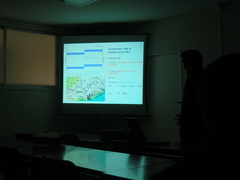Currently Visiting Researchers
Wang QI
 |
|
Self Introduction
In the past decade, all of us have witnessed a rapid increasing availability of precise geodetic measurements of present-day crustal movement thanks to GPS application to study of active tectonics. The assembled GPS dataset from China and surroundings is offering an unprecedented sampling of kinematics of continental deformation in the eastern Asia. As a consequence, not only is the new quantitative definition of these processes based on GPS-derived velocity field sharpening our understanding of style, magnitude and nature of active deformation but challenging ideas with which we ever envisaged the geological processes and forcing us to examine these processes in other way.
As a scientist in China, I am luck to be actively engaged in many exciting projects in China and international cooperation. My research include field works, data reduction and interpretation. After a considerable effort and thorough examination, my colleagues at home and abroad and I produced, for a first time in 2001, an integrated velocity field based on intensive GPS measurements in China and its margins. These GPS velocity vectors manifested a significant forward to characterize diverse styles of geological processes quantitatively. Our finding help to illustrate characteristic of active tectonics at a regional-scale of tens and hundreds of kilometers caused mostly by continental collision between India and rest of Asia.
As a geodesist committed to geological sciences, I keep on mind that regularly updated and expanding dataset of deformation rates derived from GPS measurements is one of prerequisites for a comprehensive understanding of crustal kinematics and lithospheric dynamics in Asia. Thanks to regularly tracking by the GPS network installed recently in China and newly released archives home and abroad, now I have a new opportunity to assemble velocity field from ~1800 sites (majority in China), an increases of 1 factor of 4 if compared to the GPS sites in 2001. New GPS data allow me to improve spatial resolution and accuracy of the velocity field, therefore permitting us to identify localized deformation at a wavelength of tens of kilometers. I believe firmly that such efforts is worthwhile and rewarded.
However, crustal deformation due to collision between Indian plate and Eurasian plate is not limited to China but bring about a far-field effect as far as thousands of kilometers on its surrounding regions such as Indochina, Mongolia and Siberia. Meanwhile the subduction of Philippine Sea Plate and Pacific plate along Japan trench may influence the style of deformation in the eastern China. Thus comprehensive studies on continental deformation should associate these regional processes to a framework of eastern Asian deformation and understand them as an integral with aid of an expanded GPS-inferred velocity field. This needs a close cooperation between scientists who work on this subject.
Earthquake Research Institute, University of Tokyo is a leading institution in Japan. The studies of earthquake and volcano has earned for themselves an outstanding reputation in the world. The scientists at ERI have played an important role in monitoring crustal deformation with GPS in Japan and undertaken international collaboration with other countries including China. In the past decades, cooperation between scientists at ERI and IoS was very helpful to both sides and fruitful on related subjects. That is why I readily visit ERI and work together with them on crustal movement in eastern Asia. During my staying in ERI, I plan to conduct jointly with scientist at ERI academic activities both interested in.
Seminar
Seminar about ``GPS constraint on fault slip and block rotation in deforming Asia'' was held on 20th February, 2008.
